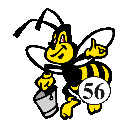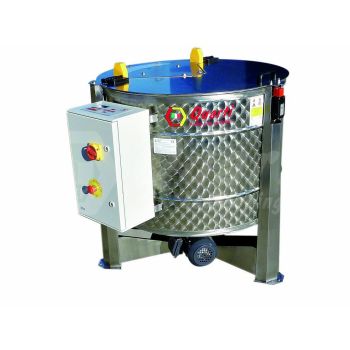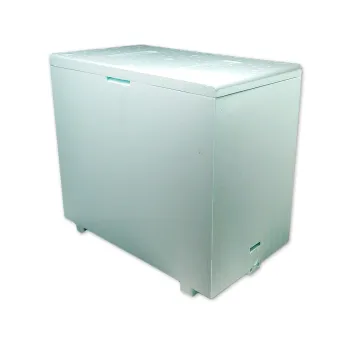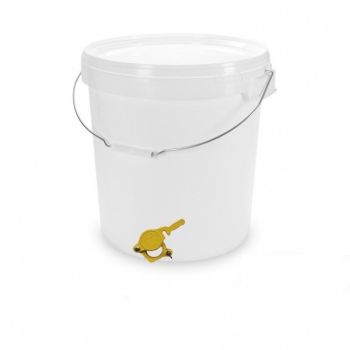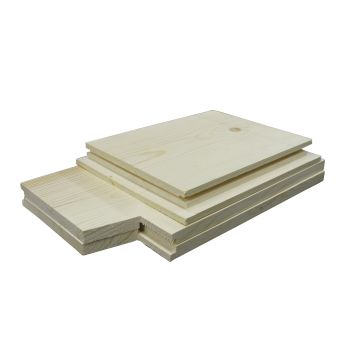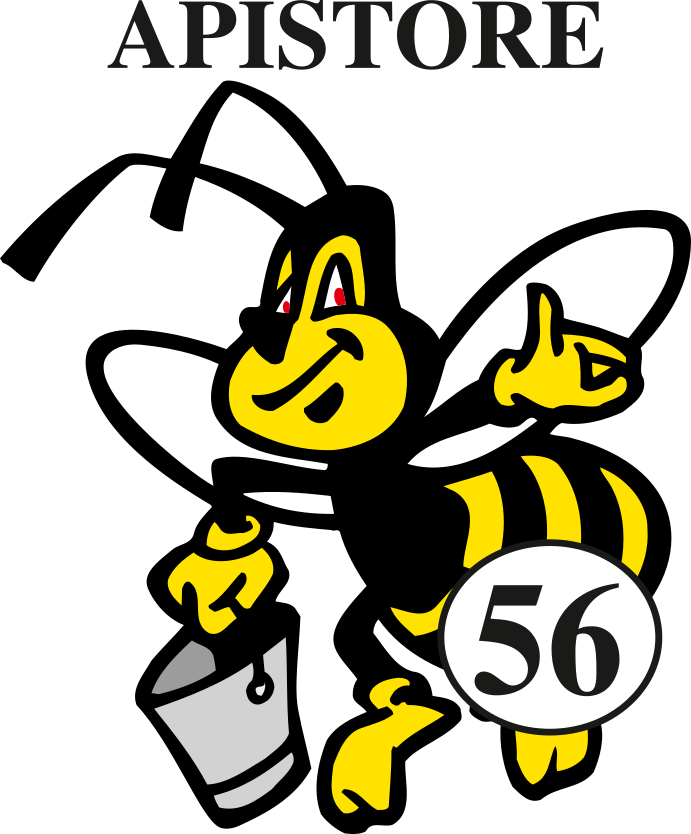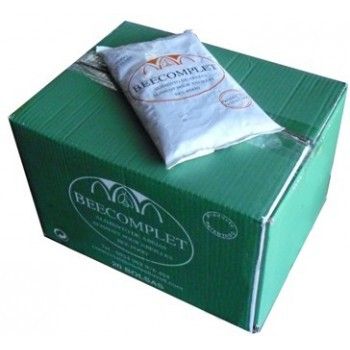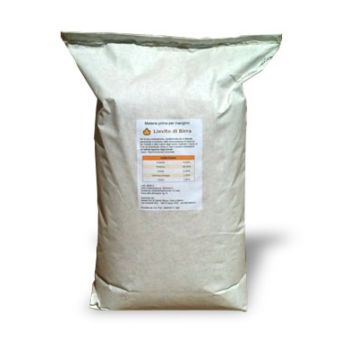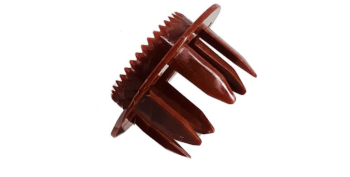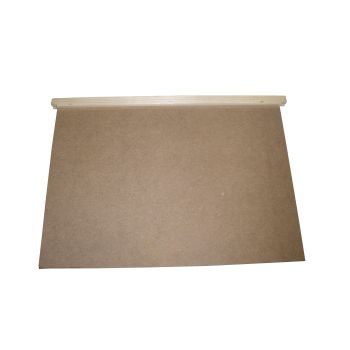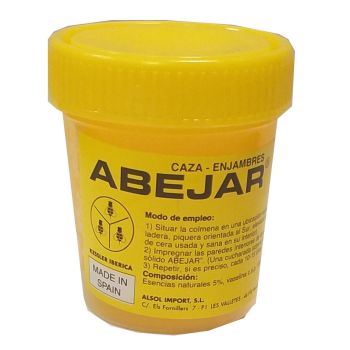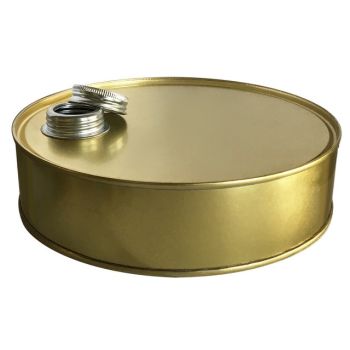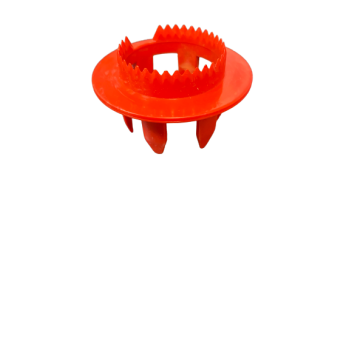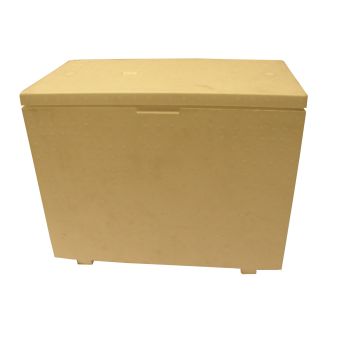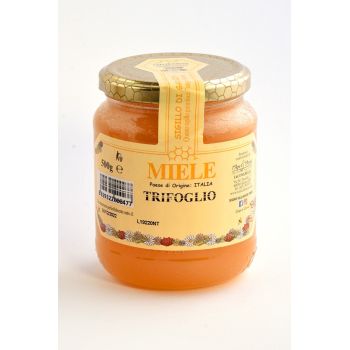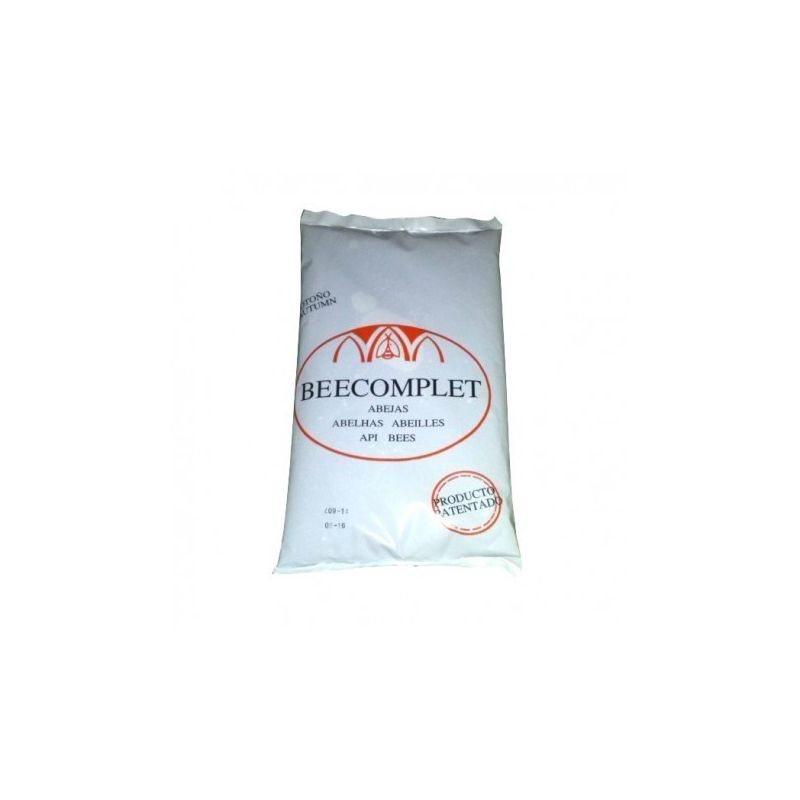

Using brewer's yeast in PROTEIN NUTRITION will result in more populous Beehives and longer longevity. Store in a dry, cool place out of direct sunlight Composition: Protein min. 40 %, Moisture max. 6 %, Crude Fat 1 %, Crude Cellulose 1 %, Minerals 14 %, Amino Acids 16 %, Vitamins 17 &% METHOD OF SUMMARY : AS SUPPLIED - In spring, after flutter cleaning, yeast is placed in front of Beehives in wide-mouthed pots. Training is done at the entrance. The amount of yeast collected can amount to 200 g/day/family. IN ENERGO-PROTEIC CAKES - 6 kg powdered sugar is mixed with 1 kg yeast. It is homogenized well, and then 2 kg bee honey is added. You mix all the ingredients and correct the consistency by adding honey.It is given in spring, autumn and dry summers in the form of 200 g cakes. IN SYRUP - maximum 10% well homogenized (1 kg yeast + 9 kg syrup). Administration is done after the honey has been harvested and extracted. Only the amount needed for one administration is prepared. If within 2-3 days the mixture is not consumed, the feeding jars are removed and cleaned. THE BENEFITS OF THE USE OF ISTANT INACTIVATED BEER YEAST IN THE FEEDING OF BEES -It enhances the appropriate development of bee families, in a manner to reach maximum development at the beginning of the great harvests from nature. -In the fall it helps in the formation of the fat body. Stimulates bee families to regain headcount and start faster. Stimulates potency. By replacing pollen brewer's yeast from unsafe sources limits the risk of diseases (loca, nosema, the black disease, etc.).
Using brewer's yeast in PROTEIN NUTRITION will result in more populous Beehives and longer longevity. Store in a dry, cool place out of direct sunlight Composition: Protein min. 40 %, Moisture max. 6 %, Crude Fat 1 %, Crude Cellulose 1 %, Minerals 14 %, Amino Acids 16 %, Vitamins 17 &% METHOD OF SUMMARY : AS SUPPLIED - In spring, after flutter cleaning, yeast is placed in front of Beehives in wide-mouthed pots. Training is done at the entrance. The amount of yeast collected can amount to 200 g/day/family. IN ENERGO-PROTEIC CAKES - 6 kg powdered sugar is mixed with 1 kg yeast. It is homogenized well, and then 2 kg bee honey is added. You mix all the ingredients and correct the consistency by adding honey.It is given in spring, autumn and dry summers in the form of 200 g cakes. IN SYRUP - maximum 10% well homogenized (1 kg yeast + 9 kg syrup). Administration is done after the honey has been harvested and extracted. Only the amount needed for one administration is prepared. If within 2-3 days the mixture is not consumed, the feeding jars are removed and cleaned. THE BENEFITS OF THE USE OF ISTANT INACTIVATED BEER YEAST IN THE FEEDING OF BEES -It enhances the appropriate development of bee families, in a manner to reach maximum development at the beginning of the great harvests from nature. -In the fall it helps in the formation of the fat body. Stimulates bee families to regain headcount and start faster. Stimulates potency. By replacing pollen brewer's yeast from unsafe sources limits the risk of diseases (loca, nosema, the black disease, etc.).
Using brewer's yeast in PROTEIN NUTRITION will result in more populous Beehives and longer longevity. Store in a dry, cool place out of direct sunlight Composition: Protein min. 40 %, Moisture max. 6 %, Crude Fat 1 %, Crude Cellulose 1 %, Minerals 14 %, Amino Acids 16 %, Vitamins 17 &% METHOD OF SUMMARY : AS SUPPLIED - In spring, after flutter cleaning, yeast is placed in front of Beehives in wide-mouthed pots. Training is done at the entrance. The amount of yeast collected can amount to 200 g/day/family. IN ENERGO-PROTEIC CAKES - 6 kg powdered sugar is mixed with 1 kg yeast. It is homogenized well, and then 2 kg bee honey is added. You mix all the ingredients and correct the consistency by adding honey.It is given in spring, autumn and dry summers in the form of 200 g cakes. IN SYRUP - maximum 10% well homogenized (1 kg yeast + 9 kg syrup). Administration is done after the honey has been harvested and extracted. Only the amount needed for one administration is prepared. If within 2-3 days the mixture is not consumed, the feeding jars are removed and cleaned. THE BENEFITS OF THE USE OF ISTANT INACTIVATED BEER YEAST IN THE FEEDING OF BEES -It enhances the appropriate development of bee families, in a manner to reach maximum development at the beginning of the great harvests from nature. -In the fall it helps in the formation of the fat body. Stimulates bee families to regain headcount and start faster. Stimulates potency. By replacing pollen brewer's yeast from unsafe sources limits the risk of diseases (loca, nosema, the black disease, etc.).
Using brewer's yeast in PROTEIN NUTRITION will result in more populous Beehives and longer longevity. Store in a dry, cool place out of direct sunlight Composition: Protein min. 40 %, Moisture max. 6 %, Crude Fat 1 %, Crude Cellulose 1 %, Minerals 14 %, Amino Acids 16 %, Vitamins 17 &% METHOD OF SUMMARY : AS SUPPLIED - In spring, after flutter cleaning, yeast is placed in front of Beehives in wide-mouthed pots. Training is done at the entrance. The amount of yeast collected can amount to 200 g/day/family. IN ENERGO-PROTEIC CAKES - 6 kg powdered sugar is mixed with 1 kg yeast. It is homogenized well, and then 2 kg bee honey is added. You mix all the ingredients and correct the consistency by adding honey.It is given in spring, autumn and dry summers in the form of 200 g cakes. IN SYRUP - maximum 10% well homogenized (1 kg yeast + 9 kg syrup). Administration is done after the honey has been harvested and extracted. Only the amount needed for one administration is prepared. If within 2-3 days the mixture is not consumed, the feeding jars are removed and cleaned. THE BENEFITS OF THE USE OF ISTANT INACTIVATED BEER YEAST IN THE FEEDING OF BEES -It enhances the appropriate development of bee families, in a manner to reach maximum development at the beginning of the great harvests from nature. -In the fall it helps in the formation of the fat body. Stimulates bee families to regain headcount and start faster. Stimulates potency. By replacing pollen brewer's yeast from unsafe sources limits the risk of diseases (loca, nosema, the black disease, etc.).
Using brewer's yeast in PROTEIN NUTRITION will result in more populous Beehives and longer longevity. Store in a dry, cool place out of direct sunlight Composition: Protein min. 40 %, Moisture max. 6 %, Crude Fat 1 %, Crude Cellulose 1 %, Minerals 14 %, Amino Acids 16 %, Vitamins 17 &% METHOD OF SUMMARY : AS SUPPLIED - In spring, after flutter cleaning, yeast is placed in front of Beehives in wide-mouthed pots. Training is done at the entrance. The amount of yeast collected can amount to 200 g/day/family. IN ENERGO-PROTEIC CAKES - 6 kg powdered sugar is mixed with 1 kg yeast. It is homogenized well, and then 2 kg bee honey is added. You mix all the ingredients and correct the consistency by adding honey.It is given in spring, autumn and dry summers in the form of 200 g cakes. IN SYRUP - maximum 10% well homogenized (1 kg yeast + 9 kg syrup). Administration is done after the honey has been harvested and extracted. Only the amount needed for one administration is prepared. If within 2-3 days the mixture is not consumed, the feeding jars are removed and cleaned. THE BENEFITS OF THE USE OF ISTANT INACTIVATED BEER YEAST IN THE FEEDING OF BEES -It enhances the appropriate development of bee families, in a manner to reach maximum development at the beginning of the great harvests from nature. -In the fall it helps in the formation of the fat body. Stimulates bee families to regain headcount and start faster. Stimulates potency. By replacing pollen brewer's yeast from unsafe sources limits the risk of diseases (loca, nosema, the black disease, etc.).
Method of use: - Place the Beehive in a strategic location for swarm passage (preferably a sunny, mid-slope location with the opening facing south, raised off the ground about 30-50 cm, with one or more used and healthy wax panels inside). - Impregnate the inside walls of the Beehive and the entrance with 10 g of paste (one level tablespoon). - Repeat the operation if necessary after 10-15 days.
Accessories:
Nutritore a coprifavo per arnia d.b. in polistirolo bianco da 6 favi (PI 0612)
Nutritore a coprifavo per arnia d.b. in polistirolo bianco da 6 favi per liquido (PI 612/C)
Coprifavo di ricambio in polistirolo (PI 1017)
Distanziatore di rinforzo frontale per arnia d.b. 6 favi in polistirolo 25mm (PI 114/N)
Guida rinforzo laterale per arnia in polistirolo d.b. da 6 favi spessa 25 mm (PI 730)
Tetto a scatola elettrosaldato per arnie d.b. 6 favi in polistirolo (FO 1042)
Coperchio in rete per trasporto arnia d.b. da 6 favi (PI 38/AA)
The Honey Crystallization ProcessAny honey can occur in the crystallized form with the exception of Acacia honey, Chestnut honey and honeydew honeys, which generally tend not to crystallize.Honey crystallization is a natural process that can occur over time. When honey contains more glucose than fructose, it is more likely to crystallize. Crystallization begins when glucose molecules aggregate to form crystals. These crystals spread through the honey, giving the solution a thicker, grainier consistency.The speed and extent of crystallization depend on various factors, including temperature and honey composition.Crystallization can take days to weeks to fully develop.
Method of use: - Place the Beehive in a strategic location for swarm passage (preferably a sunny, mid-slope location with the opening facing south, raised off the ground about 30-50 cm, with one or more used and healthy wax panels inside). - Impregnate the inside walls of the Beehive and the entrance with 10 g of paste (one level tablespoon). - Repeat the operation if necessary after 10-15 days.
Accessories:
Nutritore a coprifavo per arnia d.b. in polistirolo bianco da 6 favi (PI 0612)
Nutritore a coprifavo per arnia d.b. in polistirolo bianco da 6 favi per liquido (PI 612/C)
Coprifavo di ricambio in polistirolo (PI 1017)
Distanziatore di rinforzo frontale per arnia d.b. 6 favi in polistirolo 25mm (PI 114/N)
Guida rinforzo laterale per arnia in polistirolo d.b. da 6 favi spessa 25 mm (PI 730)
Tetto a scatola elettrosaldato per arnie d.b. 6 favi in polistirolo (FO 1042)
Coperchio in rete per trasporto arnia d.b. da 6 favi (PI 38/AA)
The Honey Crystallization ProcessAny honey can occur in the crystallized form with the exception of Acacia honey, Chestnut honey and honeydew honeys, which generally tend not to crystallize.Honey crystallization is a natural process that can occur over time. When honey contains more glucose than fructose, it is more likely to crystallize. Crystallization begins when glucose molecules aggregate to form crystals. These crystals spread through the honey, giving the solution a thicker, grainier consistency.The speed and extent of crystallization depend on various factors, including temperature and honey composition.Crystallization can take days to weeks to fully develop.
